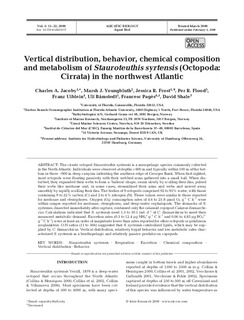Vertical distribution, behavior, chemical composition and metabolism of Stauroteuthis syrtensis (Octopoda: Cirrata) in the northwest Atlantic
Jacoby, Charles A.; Youngbluth, Marsh J.; Frost, Jessica R.; Flood, Per R.; Uiblein, Franz; Båmstedt, Ulf; Francesc, Pagès; Shale, David
Journal article, Peer reviewed
Date
2009-02-03Metadata
Show full item recordCollections
- Articles [3012]
Original version
http://dx.doi.org/10.3354/ab00117Abstract
The cirrate octopod Stauroteuthis syrtensis is a mesopelagic species commonly collected in the North Atlantic. Individuals were observed at depths >600 m and typically within 100 m of the bottom in three ~900 m deep canyons indenting the southern edge of Georges Bank. When first sighted, most octopods were floating passively with their webbed arms gathered into a small ball. When disturbed, they expanded their webs to form a ‘balloon’ shape, swam slowly by sculling their fins, pulsed their webs like medusae and, in some cases, streamlined their arms and webs and moved away smoothly by rapidly sculling their fins. The bodies of 9 octopods comprised 92 to 95% water, with tissue containing 9 to 22% carbon (C) and 2 to 4% nitrogen (N). These values were similar to those reported for medusae and ctenophores. Oxygen (O2) consumption rates of 4.6 to 25.8 µmol O2 g–1 C h–1 were within ranges reported for medusae, ctenophores, and deep-water cephalopods. The stomachs of S. syrtensis, dissected immediately after capture, contained only the calanoid copepod Calanus finmarchicus. Calculations indicated that S. syrtensis need 1.3 to 30.1 ind. d–1 of C. finmarchicus to meet their measured metabolic demand. Excretion rates (0.3 to 12.4 µg NH4+ g–1 C h–1 and 0.06 to 4.83 µg PO43– g–1 C h–1) were at least an order of magnitude lower than rates reported for other octopods or gelatinous zooplankters. O:N ratios (11 to 366) suggested that S. syrtensis catabolized lipids, which may be supplied by C. finmarchicus. Vertical distribution, relatively torpid behavior and low metabolic rates characterized S. syrtensis as a benthopelagic and relatively passive predator on copepods.
